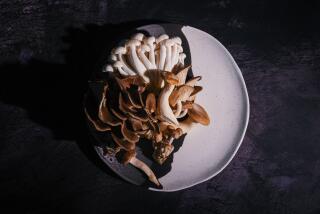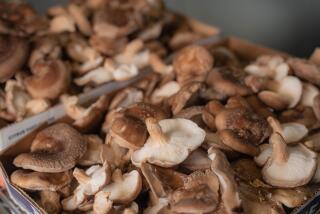Hey, Want to Grow Your Own Truffles?
- Share via
This year, skip the master gardening class about how to keep whiteflies out of your orange trees. Forget the annual pilgrimage to the nursery for zucchini starts. Plant your own truffle trees and grow something your friends will actually want.
That’s what I’ve done, with the help of a truffle grower, Mother Nature and all the patience I can muster.
The most prized truffle varieties are the white truffle of Alba, Italy (Tuber magnatum pico), and the Perigord black truffle (Tuber melanosporum). Some say the white truffle will grow nowhere but Italy; others, such as truffle expert James Trappe, claim there are suitable growing conditions in other areas--including, perhaps, the Willamette Valley of Oregon.
As for American-grown black truffles, they are already a commercial crop. Franklin Garland, proprietor of a mushroom and truffle company in North Carolina (and now worldwide at www. garlandtruffles.com), has been selling fresh domestic black truffles since the late ‘90s. Garland’s Gourmet Mushrooms & Truffles also sells hazelnut tree seedlings whose roots have been treated with the famous fungus.
For $1,400, you can buy 100 seedlings, and, in six to 10 years, with proper conditions and care, you could have truffles at a rate of a quarter pound per tree. You could eat them, or you could sell them to Garland--he pays $200 per pound or more, depending on market conditions--or to the buyer of your choice. Last winter, the preeminent truffle company, Urbani Truffles & Caviar (www.urbani.com; (800) 281-2330), was retailing fresh black truffles for $800 to $1,400 per pound.
Before reaching for your calculator and concluding that you’ve come up with a way to finance your children’s college education, consider that truffles are temperamental. Charles Lefevre, a doctoral candidate in mycology at Oregon State University and another seller of truffle seedlings (his Web site, www.truffletrees.com is still under construction), says that parts of California are perfect for truffles, but success rates can be as low as 50%, even when the host roots have been inoculated successfully.
He raises other cautions. Truffles like soil that is alkaline and chalky, which may require adding lime to your backyard. Hearing this, and having just ordered my truffle seedlings, I looked upon my navel orange tree and feared for its life. Lime. Isn’t that the killer stuff we sprinkled behind the tents at Girl Scout camp?
A simple way to test the alkalinity, or pH, of your soil is to mix a few spoonfuls of dirt with an equal amount of ordinary white vinegar in a jar with a lid. Shake the mixture and remove the lid. If you hear a soft fizzing, your soil is moderately alkaline. The more it fizzes, the higher the pH. A pH of 7 is neutral; truffles like 8 or higher. If your shortcut pH test doesn’t discourage you, ask your local County Extension office if they will perform a soil test. If you still want to proceed, order your seedlings and plant them as directed.
“Your orange tree may be able to handle it,” Lefevre told me. “Oranges are often grown in fairly arid climates that tend to have alkaline soil. Give the truffle trees as much space as possible from other trees, and gradually expand the limed area so that it takes a few years to get to the orange’s roots.”
Black truffles occur naturally between latitudes of 40 and 47 degrees north, between 300 and 3,000 feet above sea level, but given the right conditions, they will grow farther south. Though the Los Angeles Basin may be too far south for the elegant tuber, Lefevre says higher elevations in central California may be suitable. Northern California has already proven hospitable to truffles.
Californians have been interested in truffle cultivation for decades, but Lefevre is seeing new signs of truffle fever. Two months ago he was writing his dissertation when one prospector got his name, drove 800 miles to find him and appeared with a list of questions.
When Oregon wasabi grower Roy Carver was scouting land for a large truffle orchard, the Napa Valley was on his list. In the end, he chose a site in the Texas hill country, which one of his new neighbors described as “some of the sorriest country in the United States.” Both locations are well south of the truffle’s natural home.
Once you’ve selected a site, amended the soil and planted your tree seedlings, the next steps are to prune and weed as they grow. Then comes the hard part: waiting. In time, telltale truffle “marks,” or bulges, may appear around the tree in late summer, indicating you may have mature truffles in four to five months.
While you’re waiting, you’ll have to discourage other vegetation in the vicinity, with the exception of other hazelnuts. Acid-loving plants such as camellias and crape myrtles will suffer if they grow too close.
Eventually, if you’ve planted correctly, tended properly and been blessed with the right combination of sunshine, rain and moderate temperatures, you’ll find yourself popular in December and January. You’ll have the secret ingredient for a turkey stuffing your guests will swoon over, and your homemade truffle-infused oils and sauces will be on everyone’s Christmas list.
If you’ve done your best but get no truffles, you can always eat the hazelnuts. Better yet, find a good recipe for hazelnut-filled chocolate truffles.
Jill Hunting writes about wine and food from her home in Sonoma.





